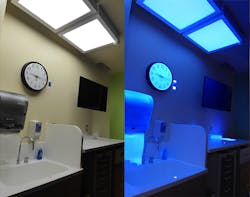LRC Evaluates Hybrid UV Lighting System in Hospitals
The Lighting Research Center (LRC) at Rensselaer Polytechnic Institute, Troy, N.Y., recently announced it is investigating alternative methods to combat the poor effectiveness of manual cleaning in hospital and health care settings. The so-called “no-touch” methods include short-wavelength light, ranging from ultraviolet (UV) to blue light (200 nm to 410 nm), which can kill pathogens through a variety of pathways, depending on the wavelength, duration, and amount. The expectation is the decontamination of patient room surfaces.
One in 25 hospital patients contract health care-associated infections (HAIs) in U.S. hospitals, according to the Centers for Disease Control and Prevention (CDC). Standard cleaning procedures usually involve manual application of detergents and disinfectants, although the efficacy of these manual cleaning procedures varies considerably. In fact, less than 50% of patient room surfaces are properly cleaned.
LRC researchers tested a hybrid lighting system, developed by GE Current, which was designed to provide both visible white light and disinfecting UV-A. The system was retrofitted into a modern hospital newborn intensive care unit (NICU) at Memorial Beacon Children’s Hospital in South Bend, Ind. The UV-A dosing was set to levels calculated safe for human occupation. Eight-hour exposures on counter surfaces were effective for suppressing pathogens identified by the CDC as highly problematic for health care facilities. LRC researchers also conducted a survey aimed at assessing the opinions of professional staff working in the NICU about the hybrid lighting system. Staff members accepted the hybrid lighting system, and the comments about the system were generally positive. An analysis of photodegrading effects suggested that UV-A resistant equipment and furnishing may need to be installed with this technology. The findings were recently published in Lighting Research & Technology.
“This lighting technology offers great promise in hospital applications,” said Jennifer Brons, director of design demonstrations at the LRC. “We are currently planning future demonstrations in another hospital unit with greater bioburden.”
According to Dr. Mark Rea, an LRC professor, reducing health care-associated infections is critical. “Unfortunately, the prevalence of these infections is only expected to rise,” he said. “The present findings should form the foundation for the next generation of this technology.”
